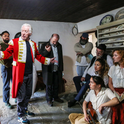Tanztheater's Kontakthof: a probing confessional collage of dance, music and speech
CLASSICAL MUSICVarèse 360° Southbank Centre, 16th-18th April, Tel: 0871 663 2583 Edgard Varèse was the tragic figure among modern music’s founding fathers. He dreamed of a music of the future, made by as-yet unknown instruments powered by electricity. Born in Paris in 1883, Varèse moved to the US during the first world war, but his hopes of finding a sympathetic hearing there were soon dashed. His life was a continual battle against uncomprehending audiences and a sceptical scientific establishment, which listened politely to the wild-haired Frenchman’s requests for help and then showed him the door. Beaten down by depression and opposition, it’s not surprising that Varèse’s oeuvre was small. But the works he managed to complete are masterly. Lacking the instruments he envisioned, he assembled choirs of brass, wind and percussion and fashioned an extraordinary, brazen music, with a savage beauty at once ancient and futuristic. His influence can be seen on younger composers and on pop musicians such as Björk and Scanner. Now, nearly 50 years after his death, Varèse’s time seems to have come. In April his complete works can be heard over three days at the Southbank Centre, performed by the London Sinfonietta and the National Youth Orchestra. Ivan Hewett is the Telegraph’s music criticARTOil Stick Work (Angelo Martinez/ Richfield, Kansas) by John Gerrard Canary Wharf underground station, 25th March 2010-25th March 2011 The longest film ever made is having its British premiere. Marvellous as it is, you don’t have to rush to see it—it’ll be on for a year. In the last decade, the use of 3D modelling software borrowed from the computer games industry has become a subgenre in art. These efforts have occasionally been witty and entertaining—see digital artist Cory Arcangel’s reworkings of Nintendo classics—but never iconic or monumental. Until now, that is, with Irish artist John Gerrard’s Oil Stick Work, a 120-sq metre, 30-year long film which is being projected in real time onto a wall in Canary Wharf station. A camera tracks slowly round and round a large aluminium grain silo in a barren landscape—the American west. For the 36-year-old Gerrard, this is a symbol of the effects of intensive farming, presented in a minimalist style that makes one think of Donald Judd and the Bechers. It carries the eerie and mesmerising atmosphere of places that are too calm—the monotony of the landscape is echoed in the monotony of the circular moves of the camera. Occasionally you may spot a small human avatar painting the wall of the shed with a black oil stick. By the end of the film in 2038, the silo will be entirely painted over. Like Gerrard’s other films, some of which were recently shown at the Thomas Dane gallery in London, this work is based on photographs of the original objects, digitised and extrapolated into the future by computer. The weather patterns have been created by using meteorological information. The times of day and seasons change. It’s a virtual reality at once everyday and hyper-real. Why 30 years? That’s the estimated time left until US oil supplies run out. Ben Lewis is an art criticTHEATREBeyond the Horizon by Eugene O’NeillSpring Storm by Tennessee Williamsdir Laurie Sansom, National Theatre, 24th March-19th June, Tel: 020 7452 3000 Two unfairly forgotten early plays by the greatest of American dramatists are joining the National’s repertoire. They transfer from the Royal & Derngate in Northampton, one of our resurgent regional theatres under the direction of Laurie Sansom, who succeeded Rupert Goold at the helm. Beyond the Horizon was O’Neill’s first big success in 1920, winning him the Pulitzer prize and announcing his major themes. It is a tale of two displaced brothers—a poet and a materialist—in love with the same woman but divided by experience (one at sea, one in farming) and then by death. “What are you trying to do,” asked the playwright’s actor father, concerned for the audience, “send them home to commit suicide?” But O’Neill was defining American theatre’s new raw realism, and the play is uncannily echoed in Williams’s Spring Storm (1937), a revelation set in a small-town Mississippi hothouse. Most theatre historians have dismissed the play, following the example of Williams’s professor at the University of Iowa who said, airily, “Well, we all have to paint our nudes.” Both men’s later work came to dominate the repertoire to the exclusion of their early plays and, in Williams’s case, some seriously underrated short plays. But Northampton audiences knew better last autumn when an excellent cast surprised and delighted them with the richness and poetry of these two three-act dramas, which offer clear evidence—more than merely sketched—of still greater things to come. Michael Coveney is chief theatre critic of Whatsonstage.comDANCEKontakthof by Tanztheater Wuppertal Pina BauschBarbican, 1st-4th April, Tel: 020 7638 8891 Pina Bausch’s dance theatre was unique, framing intimate scenes of madness, beauty and desire within visionary settings. In works like Nelken, performed on a stage carpeted with thousands of carnations, or Viktor, set in a giant earthworks, audiences saw themselves reflected and dislocated in a world of dreams. Among Bausch’s many admirers were film directors Pedro Almodóvar and Federico Fellini (in whose work she appeared). When she died suddenly last summer the shockwaves extended far beyond the dance world. Bausch’s company has recently announced plans to continue touring with her works and this Easter it brings her epic 1978 production Kontakthof to London. This probing, confessional collage of dance, music and speech is as much about the personalities of the performers as about their dance techniques. Which is why, in 2000, Bausch took the significant risk of casting it with men and women in their sixties and seventies. The result was to give a profoundly new slant on the material, so powerful and poignant that she subsequently experimented with an alternative cast aged between 14 and 19. Both versions will be fascinatingly contrasted in this Barbican run. Judith Mackrell is the Guardian’s dance criticFILMCity of Life and Deathdir Lu Chuan. On release from 16th April China is quite new to the idea of blockbuster cinema. Since the success of Hero in 2002, however, the country has become very interested in dapian Meiguo (literally “American big films”). They make money. They display technical prowess. They fit the size of the nation. Director Lu Chuan’s third film, City of Life and Death, is on the scale of a David Lean or Akira Kurosawa. Four years in the making, it is a harrowing account of the six weeks in 1937 when the Japanese army captured the Chinese city of Nanjing, killing hundreds of thousands of people and raping tens of thousands more. Like modern, western history films, Lu uses a Steadicam to suggest the literal sweep of history. And he tells the story from the point of view of a Japanese soldier as well as the Chinese characters, to avoid the charge of shrill nationalism. Once again, an Asian filmmaker composes the widescreen frame more brilliantly than western directors. Also on display is the immersive quality of cinema, seen in King Vidor’s The Big Parade (1925), Peter Watkins’s Culloden (1964), Patricio Guzmán’s The Battle of Chile (1975), Elem Klimov’s Come and See (1985), parts of Steven Spielberg’s Saving Private Ryan (1998) and Alexander Sokurov’s Alexandra (2007). Like them, City of Life and Death makes you almost feel that you are in the battle: it is one of the great history films, and one of the great war films. Mark Cousins is a critic and directorPOP MUSICGoby Jónsi (Parlophone) Landscape has always inspired music, though rarely any pop. In Iceland, however, landscape permeates everything. The groping, glassy drones of its most famous band, Sigur Rós, sound uncannily like glacial ice creaking through bleak volcanic uplands, even to those of us who have never set foot in Reykjavik. The falsetto of their elvish singer Jónsi Birgisson, meanwhile, is as pure as melting spring snow, and just as moving. On Go, Birgisson’s first solo album, we are treated not only to the same sense of Icelandic wonder, but to musical discovery, intensified by the innovative arrangements of young New York composer Nico Muhly. A graduate of the Juilliard School and former musical amanuensis to Philip Glass, Muhly is one of a new generation of composers whose classical training equals his ability in the digital recording studio, allowing him to flit between musical worlds with ease. Aside from his pop clients, who have included Antony Hegarty and Björk, the Met and ENO have just co-commissioned his first opera. On Go, Muhly’s post-minimalist influence is evident in production effects like the rhythmic chopping of backing vocals, complementing rather than usurping the pop aesthetic of Birgisson’s uplifting songs. Nick Crowe is a music writer
CLASSICAL MUSICVarèse 360° Southbank Centre, 16th-18th April, Tel: 0871 663 2583 Edgard Varèse was the tragic figure among modern music’s founding fathers. He dreamed of a music of the future, made by as-yet unknown instruments powered by electricity. Born in Paris in 1883, Varèse moved to the US during the first world war, but his hopes of finding a sympathetic hearing there were soon dashed. His life was a continual battle against uncomprehending audiences and a sceptical scientific establishment, which listened politely to the wild-haired Frenchman’s requests for help and then showed him the door. Beaten down by depression and opposition, it’s not surprising that Varèse’s oeuvre was small. But the works he managed to complete are masterly. Lacking the instruments he envisioned, he assembled choirs of brass, wind and percussion and fashioned an extraordinary, brazen music, with a savage beauty at once ancient and futuristic. His influence can be seen on younger composers and on pop musicians such as Björk and Scanner. Now, nearly 50 years after his death, Varèse’s time seems to have come. In April his complete works can be heard over three days at the Southbank Centre, performed by the London Sinfonietta and the National Youth Orchestra. Ivan Hewett is the Telegraph’s music criticARTOil Stick Work (Angelo Martinez/ Richfield, Kansas) by John Gerrard Canary Wharf underground station, 25th March 2010-25th March 2011 The longest film ever made is having its British premiere. Marvellous as it is, you don’t have to rush to see it—it’ll be on for a year. In the last decade, the use of 3D modelling software borrowed from the computer games industry has become a subgenre in art. These efforts have occasionally been witty and entertaining—see digital artist Cory Arcangel’s reworkings of Nintendo classics—but never iconic or monumental. Until now, that is, with Irish artist John Gerrard’s Oil Stick Work, a 120-sq metre, 30-year long film which is being projected in real time onto a wall in Canary Wharf station. A camera tracks slowly round and round a large aluminium grain silo in a barren landscape—the American west. For the 36-year-old Gerrard, this is a symbol of the effects of intensive farming, presented in a minimalist style that makes one think of Donald Judd and the Bechers. It carries the eerie and mesmerising atmosphere of places that are too calm—the monotony of the landscape is echoed in the monotony of the circular moves of the camera. Occasionally you may spot a small human avatar painting the wall of the shed with a black oil stick. By the end of the film in 2038, the silo will be entirely painted over. Like Gerrard’s other films, some of which were recently shown at the Thomas Dane gallery in London, this work is based on photographs of the original objects, digitised and extrapolated into the future by computer. The weather patterns have been created by using meteorological information. The times of day and seasons change. It’s a virtual reality at once everyday and hyper-real. Why 30 years? That’s the estimated time left until US oil supplies run out. Ben Lewis is an art criticTHEATREBeyond the Horizon by Eugene O’NeillSpring Storm by Tennessee Williamsdir Laurie Sansom, National Theatre, 24th March-19th June, Tel: 020 7452 3000 Two unfairly forgotten early plays by the greatest of American dramatists are joining the National’s repertoire. They transfer from the Royal & Derngate in Northampton, one of our resurgent regional theatres under the direction of Laurie Sansom, who succeeded Rupert Goold at the helm. Beyond the Horizon was O’Neill’s first big success in 1920, winning him the Pulitzer prize and announcing his major themes. It is a tale of two displaced brothers—a poet and a materialist—in love with the same woman but divided by experience (one at sea, one in farming) and then by death. “What are you trying to do,” asked the playwright’s actor father, concerned for the audience, “send them home to commit suicide?” But O’Neill was defining American theatre’s new raw realism, and the play is uncannily echoed in Williams’s Spring Storm (1937), a revelation set in a small-town Mississippi hothouse. Most theatre historians have dismissed the play, following the example of Williams’s professor at the University of Iowa who said, airily, “Well, we all have to paint our nudes.” Both men’s later work came to dominate the repertoire to the exclusion of their early plays and, in Williams’s case, some seriously underrated short plays. But Northampton audiences knew better last autumn when an excellent cast surprised and delighted them with the richness and poetry of these two three-act dramas, which offer clear evidence—more than merely sketched—of still greater things to come. Michael Coveney is chief theatre critic of Whatsonstage.comDANCEKontakthof by Tanztheater Wuppertal Pina BauschBarbican, 1st-4th April, Tel: 020 7638 8891 Pina Bausch’s dance theatre was unique, framing intimate scenes of madness, beauty and desire within visionary settings. In works like Nelken, performed on a stage carpeted with thousands of carnations, or Viktor, set in a giant earthworks, audiences saw themselves reflected and dislocated in a world of dreams. Among Bausch’s many admirers were film directors Pedro Almodóvar and Federico Fellini (in whose work she appeared). When she died suddenly last summer the shockwaves extended far beyond the dance world. Bausch’s company has recently announced plans to continue touring with her works and this Easter it brings her epic 1978 production Kontakthof to London. This probing, confessional collage of dance, music and speech is as much about the personalities of the performers as about their dance techniques. Which is why, in 2000, Bausch took the significant risk of casting it with men and women in their sixties and seventies. The result was to give a profoundly new slant on the material, so powerful and poignant that she subsequently experimented with an alternative cast aged between 14 and 19. Both versions will be fascinatingly contrasted in this Barbican run. Judith Mackrell is the Guardian’s dance criticFILMCity of Life and Deathdir Lu Chuan. On release from 16th April China is quite new to the idea of blockbuster cinema. Since the success of Hero in 2002, however, the country has become very interested in dapian Meiguo (literally “American big films”). They make money. They display technical prowess. They fit the size of the nation. Director Lu Chuan’s third film, City of Life and Death, is on the scale of a David Lean or Akira Kurosawa. Four years in the making, it is a harrowing account of the six weeks in 1937 when the Japanese army captured the Chinese city of Nanjing, killing hundreds of thousands of people and raping tens of thousands more. Like modern, western history films, Lu uses a Steadicam to suggest the literal sweep of history. And he tells the story from the point of view of a Japanese soldier as well as the Chinese characters, to avoid the charge of shrill nationalism. Once again, an Asian filmmaker composes the widescreen frame more brilliantly than western directors. Also on display is the immersive quality of cinema, seen in King Vidor’s The Big Parade (1925), Peter Watkins’s Culloden (1964), Patricio Guzmán’s The Battle of Chile (1975), Elem Klimov’s Come and See (1985), parts of Steven Spielberg’s Saving Private Ryan (1998) and Alexander Sokurov’s Alexandra (2007). Like them, City of Life and Death makes you almost feel that you are in the battle: it is one of the great history films, and one of the great war films. Mark Cousins is a critic and directorPOP MUSICGoby Jónsi (Parlophone) Landscape has always inspired music, though rarely any pop. In Iceland, however, landscape permeates everything. The groping, glassy drones of its most famous band, Sigur Rós, sound uncannily like glacial ice creaking through bleak volcanic uplands, even to those of us who have never set foot in Reykjavik. The falsetto of their elvish singer Jónsi Birgisson, meanwhile, is as pure as melting spring snow, and just as moving. On Go, Birgisson’s first solo album, we are treated not only to the same sense of Icelandic wonder, but to musical discovery, intensified by the innovative arrangements of young New York composer Nico Muhly. A graduate of the Juilliard School and former musical amanuensis to Philip Glass, Muhly is one of a new generation of composers whose classical training equals his ability in the digital recording studio, allowing him to flit between musical worlds with ease. Aside from his pop clients, who have included Antony Hegarty and Björk, the Met and ENO have just co-commissioned his first opera. On Go, Muhly’s post-minimalist influence is evident in production effects like the rhythmic chopping of backing vocals, complementing rather than usurping the pop aesthetic of Birgisson’s uplifting songs. Nick Crowe is a music writer












